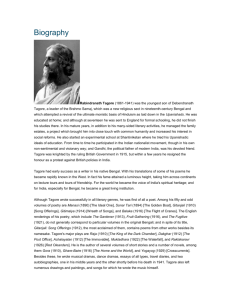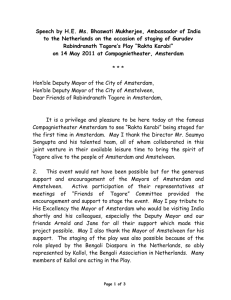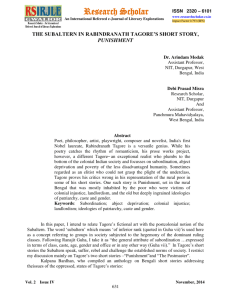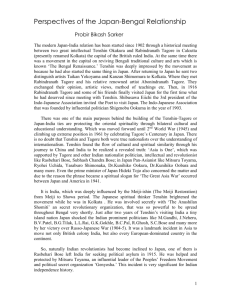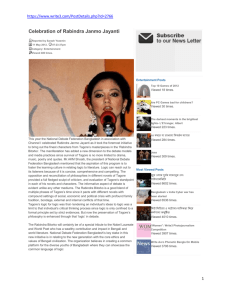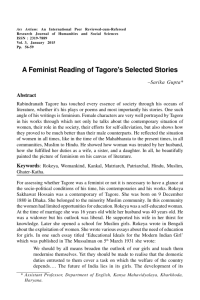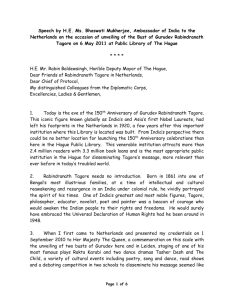Spanish
advertisement
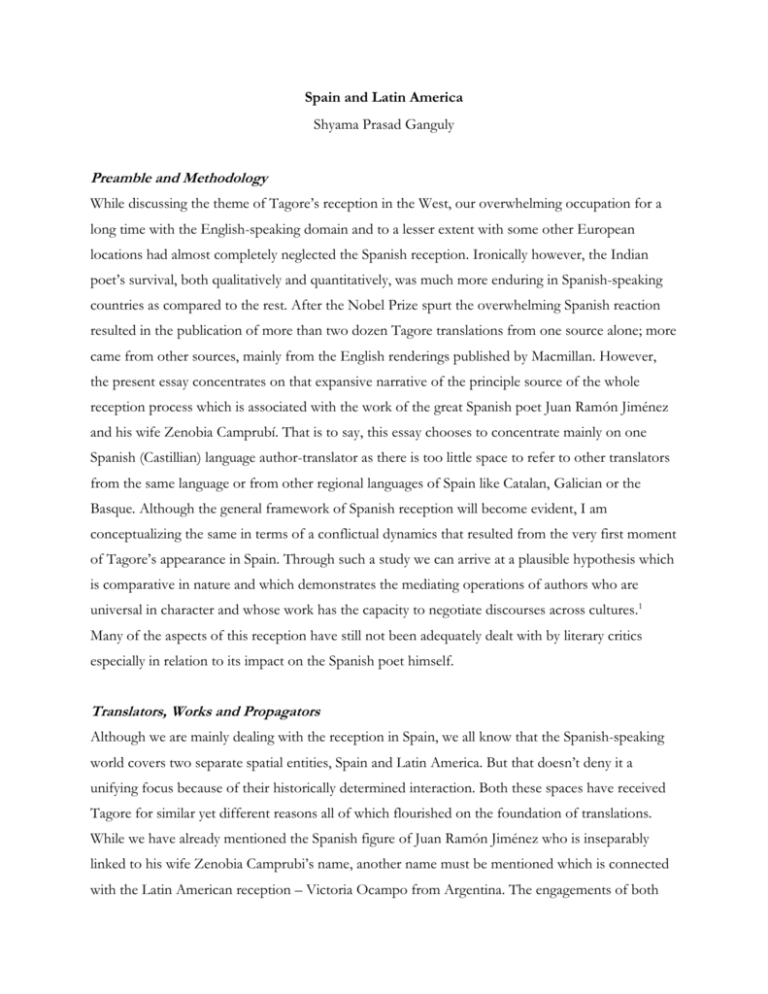
Spain and Latin America Shyama Prasad Ganguly Preamble and Methodology While discussing the theme of Tagore’s reception in the West, our overwhelming occupation for a long time with the English-speaking domain and to a lesser extent with some other European locations had almost completely neglected the Spanish reception. Ironically however, the Indian poet’s survival, both qualitatively and quantitatively, was much more enduring in Spanish-speaking countries as compared to the rest. After the Nobel Prize spurt the overwhelming Spanish reaction resulted in the publication of more than two dozen Tagore translations from one source alone; more came from other sources, mainly from the English renderings published by Macmillan. However, the present essay concentrates on that expansive narrative of the principle source of the whole reception process which is associated with the work of the great Spanish poet Juan Ramón Jiménez and his wife Zenobia Camprubí. That is to say, this essay chooses to concentrate mainly on one Spanish (Castillian) language author-translator as there is too little space to refer to other translators from the same language or from other regional languages of Spain like Catalan, Galician or the Basque. Although the general framework of Spanish reception will become evident, I am conceptualizing the same in terms of a conflictual dynamics that resulted from the very first moment of Tagore’s appearance in Spain. Through such a study we can arrive at a plausible hypothesis which is comparative in nature and which demonstrates the mediating operations of authors who are universal in character and whose work has the capacity to negotiate discourses across cultures.1 Many of the aspects of this reception have still not been adequately dealt with by literary critics especially in relation to its impact on the Spanish poet himself. Translators, Works and Propagators Although we are mainly dealing with the reception in Spain, we all know that the Spanish-speaking world covers two separate spatial entities, Spain and Latin America. But that doesn’t deny it a unifying focus because of their historically determined interaction. Both these spaces have received Tagore for similar yet different reasons all of which flourished on the foundation of translations. While we have already mentioned the Spanish figure of Juan Ramón Jiménez who is inseparably linked to his wife Zenobia Camprubi’s name, another name must be mentioned which is connected with the Latin American reception – Victoria Ocampo from Argentina. The engagements of both from the two sides of the Atlantic were basically responsible for Tagore’s initial popularity in the Spanish-speaking world. It would be fair to underline that they were not the first ones to show interest in Tagore nor was the famed Gitanjali the first work to be translated in the Spanish domain. Besides, leading literary figures like Gabriela Mistral, Pablo Neruda (Chile), Dulce María Loynaz (Cuba), José Vasconcelos (Mexico), Cecilia Meireles (Brazil) and a series of educationists and reformers from different countries of Latin America showed deep interest in Tagore’s creations.2 It is significant that the first book that may have been taken up for translation in the Hispanic world was Hundred Poems of Kabir by the well-known Argentine educationist Joaquín V. González in 1914, an engagement that must have started immediately after the English version of 1914. In Spain even though the first work to be translated by the Jiménez couple was The Crescent Moon in 1915, it was the Galician intellectual Vicente Risco who made the first reference to Tagore after reading The Mystic Way by Evelyn Underhill in 1912. (see Portuguese Reaction pp.xxx-xxx.) In fact, Risco’s first reaction to The Crescent Moon, The Gardener and Sadhana, published by Macmillan in 1913, was so engaging that he was even nicknamed the Spanish Tagore! He also delivered a lecture on Tagore in late 1913, after the Nobel Prize announcement, at the famed institution called the Ateneo de Madrid. With time, however, Risco got disillusioned with Tagore and critical of his philosophy due to his progressive inclination towards extreme nationalism and fascism. Almost at the same time as Risco, in August 1913, the well-known author Pérez de Ayala wrote in the magazine La Tribuna about the great interest of the English world in Gitanjali. But even before the Spanish translations started appearing another prestigious writer, Ramiro de Maeztu, offered a strong criticism of what he understood as the Tagorean philosophy. To him it was something inert and “sleep-inducing’ from his reading of “The Realization of Life”, published in the newspaper Nuevo Mundo, on 5 March 1914. These views3 of Risco and Maeztu, may be considered the signal of the dynamics of reception that we are trying to elaborate. Although criticism came from other writers of repute in Spain4, as we shall refer to a little further, it was the outstanding works of the Jiménezs, coupled with the popular perception, that eventually led to the enduring reception. The Jiménez Couple as the Central Source: A Case Study of Gitanjali The Jiménez couple’s relationship with Tagore started after Zenobia, the future wife of Juan Ramón, read some of the first English poems of Tagore appearing in Poetry, a US magazine. She sent it to her poet friend in Spain who was already the leading literary figure there. Apart from its impact on the intimate personal biographies of the Spanish pair, this is the beginning of a poetic relationship which resulted in the production of more than twenty works of Tagore in Spanish. But surprisingly, the Spanish couple’s first translations were that of The Crescent Moon and of four other collections, but not of Gitanjali. It was only in 1918 that they translated the latter with the title Ofrenda Lírica (literally Lyrical Offering). Around the same time as Zenobia’s encounter, another important lady of letters from Latin America, the Argentine Victoria Ocampo, also had the occasion to read some of the poems of Gitanjali in English translation. Her first reaction is well recorded in many books and articles published in India5. The Argentine reaction is included in this volume (see pp. xxx-xxx). The Argentine reaction as a whole, along with the impact of the Jiménez couple’s translations, evoked a profound response from many Hispanic poets and writers. The best representations of the same are to be found in Jiménez’s own poetic reaction to and handling of Gitanjali and other collections in the Spanish peninsula as well as in the philosophical reflections on Gitanjali, registered in the work of the well-known Argentine poet Eduardo González Lanuza in Latin America.6 Let us reflect on the same briefly.7 As expected, all the 103 poems in Spanish translated by the Jiménez couple were taken from the English version, dedicated to William Rothenstein, which was a collection of poems translated from the Bengali books naivedya, kheya, gitanjali and several others. In spite of Jiménez’s interest in finding a Bengali-knowing person in Spain, all translations had to be inevitably done from the English versions. However, Jiménez did consult André Gide’s French translation and it is evident from a comparison of the two that he decided to exercise more liberty than Gide. We may keep in mind the two domains of the Jiménez reception. One, the very corpus of his translation of the Gitanjali poems; and two, the interiorisation and enrichment of his own poetic and philosophical ideas as a result of this contact.8 We shall avoid going into the latter aspect and only touch upon the former. Let us point to a few details of the first aspect.9 It may be well to remember how Jiménez himself felt that the English translations suffered from certain weaknesses. Probably this realization prompted him to exercise some liberty, although on the whole the translations were quite faithful to the original. The slight variances were also due to the differences in the structure of the languages. The high quality attained by Jiménez was of course aided by his complete mastery of the genre of prose poems. Let us now cite a couple of representative examples of the operational process and impact of the translations. A) Original in English: - My song has put off her adornments. She has no pride of dress and decoration. Ornaments would mar our union; they would come between thee and me; their jingling would drown thy whispers.10 Translation in Spanish: Mi canción, sin el orgullo de su traje, Se ha quitado sus galas para tí Porque ellas estorbarían nuestra unión, Y su campanilleo ahogaría nuestros suspiros A literal translation of the above in English:My song, without the pride of her dress, Has put off her adornments for you, Because they will spoil our union, And their jingling will drown our sighs (whispers). Readers can immediately note some of the changes made by Juan Ramón Jiménez. Two phrases in English have been turned into one in Spanish. The expression “Para tí” (for you) has been added in Spanish. Even the separating entreaties like ‘thee’ and ‘me’ in English have been combined into one, which is ‘nuestra’ (our) into Spanish. We can see a similar process in another extract, for example: B) Original in English: My poet’s vanity dies in shame before thy sight. O master poet, I have sat down at thee feet. Only let me make my life simple and straight, like a flute of reed for thee to fill with music.11 Translation in Spanish: Mi vanidad de poeta muere de vergüenza ante ti, Señor, poeta mío. Aquí me tienes sentado a tus pies. Déjame solo hacer recta mi vida, y sencilla, Como una flauta de caña, para que tu la llenes de música. The literal translation of the above in English: My vanity of poet dies in shame before you, Lord, my poet. Here you have made me seated at your feet. Let me only make my life straight and simple like A flute of cane, so that you may fill it with music. Here again we can see how Jiménez coins the expression ‘Señor, Poeta mío’ (Lord, my poet) instead of the original ‘O Master poet’. This may not suggest any major liberty, but if we compare his version with that of André Gide the differences become a little more pronounced. Most importantly, Juan Ramón has tried to maintain his own style and structure without quite literarily attempting to translate from the English version. The second paragraph of poem no. 24 of Gitanjali starts as “From the traveller, whose sack of provisions is empty before the voyage is ended […], remove shame and poverty…” Here Jiménez has moved the last part to the beginning. He has also reduced a few alankaras (adornments) and made them as simple as possible. At some places he has introduced some of his favourite expressions like “no sé qué” (I don’t know what). For example, in the poem no. 2 of Gitanjali Tagore’s “…one sweet harmony” becomes “…no sé qué dulce melodía”. The indeterminate nature of this Spanish expression introduces an additional dimension into the meaning. It is evident that Jiménez’s main objective in taking this liberty was to present Tagore to the Spanish reader in the most acceptable form as a powerful poet. In this process he was able to remove the weariness and lack of variety in the English version. It is not out of place to mention that the reaction of many of the informed readers of poetry to the Jiménez rendering of Tagore has been as lively as the reaction of many Bengali readers to the original Bengali. In some of the Spanish lines we find the structure closer to Bengali, a feat that must have been achieved intuitively through a process of re-creation as of the English version. As indicated earlier, the two most prominent examples of the impact were Victoria Ocampo and the Jiménez couple. Ocampo’s personal relationship with Tagore grew more and more intense after she hosted him in Buenos Aires in 1924. She conceived this in terms of the imagery of her being like a seeking tree and Tagore the sky who provided light and nourishment to her.12 She has also left ample written admission of the impact the Gitanjali verses had on her. Similarly, Zenobia mentioned in one of her letters how near to their souls Tagore has been in all these years. The impact of Tagore on Jiménez’s poetic work from a certain period is also part of this nearness. His lyrical prologue to the translation of Gitanjali is an unparalleled testimony of the process which leads to this impact. This is what the Spanish poet has to say on the subject, in my translation: To Rabindranath Tagore We have tried to give a new body to your great soul, to this book where you wanted to put your full and true soul. Will it move your soul with its blood and its rhythm? Will it beat free, in our body? Tell me how does your soul find itself in this body of ours? Does our word cast its shadow a bit in your immense joy, in that sandy expanse of joy, kin only of the sea of paradise? Does it shine as the great star and come down from your night of adventures? Can you lift your fire with it to the zenith; can you make your pensive love quieter with it, like the subterranean water? You are going to be heard in our words – fortune of others –by your God! Will they be enough for your God to come to listen to your soul under our skies? Can you talk to him freely, with our Spanish voice, to a God who is yours, closer, visible, human who listens to beautiful words?13 Jiménez saw Gitanjali as a dialogue between the poet and his God. This is not a God who is just full of beauty, nor does He only appear to the poet in a human form, but He is one who also loves to listen to beautiful words. It is this concept of beauty that explains the approach of Jiménez to Tagore. More than anything else he is keen that Tagore’s God should descend under the Spanish sky with the same kind of beautiful words as were used in the Bengali poet’s own language. This made the dialogue and relationship between the two so endearing, marked by nearness and visibility. Therefore Jiménez is most concerned to create that body for Tagore’s soul in the Spanish domain whose primary element ought to be the beauty of words. Here, as in other translations by him, he is keen to create a dialectic structure between the body and the soul and the new body that he creates in his poetic endeavour must let the Tagorean soul feel free and spontaneous. Through this process Jiménez tries to create for himself the proposed big challenge of a free interactive and spontaneous flow between Tagore, his God, Jiménez himself and the Spanish readers. In the process we become aware also of the fact that Jiménez enters into the world of Tagore and turns it into a part of his own poetic world. He wouldn’t have continued translating and recreating more than 1.200 pages from Tagore’sœuvre had there not been an internal compulsion; an illuminating discovery while dealing with “a truly extraordinary poetry”, as he himself admitted. The Spanish Literary and Historical Ambience of the Period During this phase of evolution, around 1915, we know through Jiménez’ own words how he felt the need for inspiration from a foreign poetic tradition. Since he was himself the symbol of a literary epoch, this inspiration would naturally spread to the cultural and literary ambiance of that epoch. One knowledgeable biographer of Jiménez, intimately connected to his evolution, Francisco Garfias, had to say the following of Tagore : The moment of Tagore’s appearance in Spain was crucial to Spanish poetry. The great Rubén (Darío) was dead and the neck of the modernist swan had been twisted, although it continued producing agonising songs from second ranking poets, stiff as they were with their accent on the antipenultimate syllables and weary of pagan deities. Spain was looking for a more intimate and natural poetry, dismounted from a cold parget or artificial marble pedestal. Unamuno, Machado and Jiménez followed different (expressive) paths and were saying things in different ways. Unamuno with his strong personality was making restive blank-verses, full of humanism and tremor. Machado put an unusual truth in his moving poems, but in 1913 when Tagore gets the Nobel Prize and becomes famous world-wide, in Spain there was still no outstanding book of poetry, a book that could open new lyrical paths for future generations. In 1916, in his collection Diary of a recently married poet Juan Ramón Jiménez invents a new form which is so different from everything written before. From the Diary whose free verse came from the sea, as the poet himself was to say, arose all the later poetry: Leon Felipe, Guillen, Salinas… But before this poetic event indicated above, Rabindranath, supported by the Nobel Prize and his profusion of books of poetry, essays, dramas, aphorisms, novels and short-stories, with his subtle articulations, had already captured the attention of the Spanish reader. After the slanderous spirits, the princesses and Bacchantes (of the Spanish Modernists poetry) Tagore erupted (in the minds of the Spanish readers) with his sun, his cloud, his half open flower, his sleeping child and his crescent moon… The poetic material used by Tagore carried the promise of communicating to the ears a poetry full of fragrance of the sunny fields, of sudden springs, of peace, of solitude and a dialogue with God, a poetry that was called upon to shake and freshen up a little the plaster-ridden dry Spanish poetry of that period. From the Bengali poet, through Juan Ramón, many of the poets of succeeding generations drank an exquisite juice, and from the author of The Gardner the Chilean Pablo Neruda learnt […] his first blind and suggestive enumeration of plants and animals which were later to impress his readers so much.14 This reception was produced in the midst of the new realities of a post-imperial Spain that was going through major changes and adjustments in the first decades of the twentieth century. Many leading figures of artistic and intellectual life opened to new mentalities – including to alternative epistemological constructions. Here one notes the presence of the opportunity which historians have called the ‘historical inversion’ of Spain. Ortega y Gasset joined this wave in favour of the new mentality and he saw in Tagore the reaffirmation of the very new humanism and the vision of reality based on what he championed as his philosophy of vital reason. He was perhaps the first Hispanic figure who unfolded a philosophical exegesis of the writings of Tagore. His famous and fascinating epistolary explanation of some of these texts, particularly of The Crescent Moon and The Post-Office , offers an alternative vision of human reality15. He convincingly voiced the philosophical significance of the unprecedented vision represented by a child in both works. The celebration of childhood for him constituted an eternal human dimension with Tagore appearing as the unsurpassed representative of a universal spirit that can relate the child’s aspirations and dreams with every individual’s identity. His illuminating analysis of the child protagonist Amal in The Post-Office- “a child that all of us carry within us”- aimed at highlighting the importance of the Tagorean discourse across cultures. He raised him to Biblical proportions and qualified him to be an “Oriental David” who need not be defined but read to experience how he breaks open the closed door of all sensibilities. This is akin to the creative dialogue sustained by Jiménez at the literary level in his “colofones líricos” which was composed in response to the different works by Tagore which he translated with Zenobia. We have referred to the fertile ground that was the Spanish period during the initial decades of the twentieth century insofar as the reception of external currents was concerned. This historical reality in Spain certainly contributed to the positive reception of Tagore. Known as the “silver period”, the years between 1900 and 1936 represent a new impulse for literary, artistic and scientific movements. The national culture also acquired an intense stimulus of self-criticism and evaluation. While regional cultures got a push, there was a reformist and liberal orientation through an institutionalised attention by the central government. One of the major influences on the first nucleus of writers of the twentieth century was the German philosopher Karl Christian Friedrich Krause (1781-1832) whose ideas promoted the identification of a national mentality. Krause’s rationalism and new humanism as well as the Free Institution of Learning created earlier for promoting the reformist spirit in all spheres, opened the doors for the reception of philosophies, movements and cultural tendencies from other spaces. The fact that the “veneration of the child, which in other words meant respect for the future”, was to become an accepted objective explains why the Tagorean evocation of the child had so much of attraction for the Spaniards. The institutionalist spirit promoted the creation of various institutions that propagated the expression and free exchange of ideas and, aided by the leading intellectuals of the day. Education and national questions became the starting point for many insightful essays by thinkers and artists of that moment. For example, the Residencia de Estudiantes and the Residencia de Señoritas were two typical centres highlighting this concern. In the open atmosphere of these institutes where intellectuals, students, writers met, the first translations of Tagore were presented and discussed by Zenobia and Juan Ramón Jiménez who was the principal figure in the then Residencia de Estudiantes. The two other outstanding figures who participated during such presentations were Ortega y Gasset and Gregorio Marañon. Critical Dimensions and the Responses The most critical reactions came from equally well-established figures who found the message and content of the first translations from the Jiménez couple unacceptable mainly due to the ideological implications of the Tagorean discursive universe. According to them Tagore should not gain preference over the dominant poetic or realist-naturalist narrative tradition of Spain. Against the furore of these voices, indirectly aimed at Jiménez, the latter and many others stood firmly. Jiménez’s own search for new canons at a particular moment of his poetic career, his creativity supported by the gradual expansion of reader response to their translations drowned those criticisms after some time. He himself was known to have reservations about certain “defects” of the mystics of the Orient. No less significant was the position taken by those intellectuals and pedagogues of the Spanish Catholic Church who were deeply impressed by Tagore’s ideas, experiences and writings on education. The negative campaigns came from well-known writers like Emilio Pardo Bazán and Eugenio d’Ors, besides from some journalists and critics. In one of her last pieces of strong criticism, Pardo Bazán, an exponent of the naturalist movement, echoed the pre-existing western valorisation of the so-called passive philosophy of life of the East projected in Tagore’s work. According to her, Tagore belongs to a race frequently given to “dreaming with eyes open”, a race which promoted the idea of ‘beatified nirvana’. By that she probably meant a passive surrender to the idea of deliverance from sufferings made possible by a belief in moksha. That is why India, according to her, could not occupy the place it deserved with its philological aristocracy, its ethnographic purity, nobility and territorial expansion that its splendorous nature had given her16. This longish piece was written for a popular newspaper probably to stem the popularity of the translations whose sales had multiplied exponentially. This popularity is echoed in an exchange of letters between the Jimenez couple on the subject. Such a reaction was also due to the gradual disappearance of the prevailing movements of naturalism-realism and Spanish ‘modernismo’ which failed to set guidelines for the future. She insisted that there was nothing new worth emulating in the mystic content of Tagore’s religious philosophy. They were “subjective emotions converted into divinity”. In that respect she takes recourse to what (the French philosopher and social theorist) Michel Foucault conceptually calls “comparison of measures”. According to this all analysis is done to establish relations of equality or superiority in place of doing comparison of orders. In Foucault’s terms she was establishing hierarchical canons of primary and secondary authors, strong and weak cultures. While Jiménez and others like Ortega y Gasset, from a comparative perspective, saw a clear need for dialogue across cultures and a multi-cultural understanding of differences, Pardo Bazán stridently compares the mysticism of Tagore with that of Spanish mystics who according to her were never resigned to passive meditation because they were people of ardent activities and very sure and concrete in there thinking. That’s why she rejects the universality of the poetics of Tagore, saying that it was pure emotion and did not need any mystic adornments. One notes in Tagore’s works, according to her, a type of dialogue with someone invisible and idealised. His poetry “escapes from the soul in the same way as water from the basket”. This accusation of dilution and vagueness can be contrasted with the Juan Ramón’s exuberance about the lyrical precision of Tagore to whom, many years later, he devoted some very telling verses. Jiménez who has a famous poem where he asks Intelligence to bestow on him “the exact name of things”, remembered Tagore with the following verses: Where is the word heart the word that softens the hard world with love the word that gives forever- at this moment the strength of a child the resistance of a rose. 17 Similarly, these other verses, perhaps the first draft of a dedicatory poem, which recall for him the close relation between life and verse, connected with his vital experience during his Tagore phase: Luz de la atención (Rabindranath Tagore) Verses, pure chalices It is there where I pour my blood Without a single drop being wasted, It is there where my life becomes new Not spilled in vain for things; Verses, loving hands (arms) Will keep forever, in fullness the soul of my hands (arms) --- lovers of my arms my legs and my wings This Spanish poet saw in Tagore the response and example to follow in his own search of the exact expression or name of things through words. Pardo Bazán’s criticism is perfectly explicable. The subversive potential of the vision of reality derived from another epistemological construction posed a threat to the western codes, especially in the epoch of transition. The acceptance of Tagore by a large number of Spanish readers obliged Pardo Bazán to warn them to give creditability only to those aspects of Tagore’s work that were based on some measure of reality close to its western notion. And in this sense Maeterlinck was found to be closer to a poet from the Orient. The West did not need to imitate the excessive sentimentalism and the timid orientation which was represented by the “pillow of feathers” on which Jiménez was accused by writer like Eugenio d’Ors to have gone to sleep. In his view, the pillow needed to be shaken up. We must underline the fact that the example of Tagore’s reception and the controversies arising therefrom do reflect to a large extent the conflict of ideas in Spain during the first quarter of the twentieth century. Alarmed by war mongering that loomed large ever since the First World War, Tagore appeared to be a messiah to many. He was seen as the harbinger of an epochal message for all humanity, but most relevant for Europe. This dimension is so evident in the assessment of another great Spanish poet of the time, Antonio Machado. In one of his poems dedicated to the Indian poet, cited here only in part, he tellingly puts it thus: Rabindranath, your heart has been heard in this peninsula of the West. On this autumn eve when rain clinks on the bamboos and showers spread over your Bengali sky, war thunders and the river of life is becoming stormy in the dark Europe. Your book comes to this bleeding Europe -Clamouring with war and trouping soldiers – Like the story of Gautama that arrived one day. In this Europe, on the white bull, Shiva mounts, military crests are nothing but rude wild promises, the war would spread through the seven seas.18 Machado, one of the finest poets of the famed Spanish Generation of ‘27 , of no less literary merit than Juan Ramón Jiménez, was not only overwhelmed by the creative output of Tagore, but he also enthusiastically welcomed Tagore’s message after reading the first translations between 1915 and 1918. This is represented by the expression “your book” referring to The Crescent Moon and The Gardner and Gitanjali . Plays, Pedagogy, Press – a Brief Consideration Tagore symbolised the pull of forces in opposite directions. On the one hand, his works gave rise to important controversies among writers, on the other, oblivious of these controversies, popular reception gave him instant approval. This is surprising due to the limited nature of knowledge of his entire œuvre. The total number of works translated by the Jiménez couple was around twenty, all done in the first few years. Of these eight were plays. Some of these plays were also represented in those initial years. The Post-Office and The King and the Queen were staged in the famed theatre La Princesa of Madrid in 1920 and at Hotel Ritz in 1921 respectively to full houses and followed by much applause. But the shows were never repeated. They were praised for their universal symbolism and idealism.19 From today’s perspective, it is difficult to avoid lamenting the cancelled visit of Tagore to Spain20, for, among other things it stalled the staging of his play Sacrifice. It was being rehearsed in honour of his visit. Incidentally, Federico García Lorca was acting as Jaising. Neither the visit nor the production of the play saw the light of day. This opportunity in the history of Indo-Spanish literary relations would have not only encouraged the immediate unfolding of Tagore’s other dimensions but also made him conscious of the great Spanish literary tradition. The various facets of Tagore were also hardly known; only in the later decades the initial impulse created curiosity for further exploration in the area of his philosophy, short-stories and education. Even some of the unpublished translations by the Jiménez couple also came out later.21 In 1961, Jiménez Martos wrote on Tagore as a sociologist, political thinker and essayist22. One of the best pieces on Tagore’s creative pedagogy was written by Ramón Castelltort in 196423. In fact Spanish newspapers too, whether after his death or to commemorate his birth or death anniversaries, kept publishing eulogies as well as analytical articles on the poet, his life, work and relevance.24 Some Reflections from Latin America25 Looking across the Atlantic, the Chilean poets Gabriela Mistral and Pablo Neruda received Tagore in a very positive light. However, César Vallejo (Peru) and Jorge Luis Borges (Argentina) were known for their adverse opinion of Tagore’s poetics. Mistral, after a careful study of the Indian poet came to the conclusion that Tagore belonged to a culture which “had the ability to completely transform knowledge into a spiritual experience”. She was deeply influenced by the fact that Tagore happened to be that “rare poet who wields the knowledge of all sciences and yet, as Maragall would say, sings like a shepherd”.26 – “[He] is a poet of spontaneous inspiration that transcends all demands of artificiality of reason and technique.” In her view, In the West the notion of culture operated in a crude manner where the instrument is too heavily felt. The fabrication, as seen by Abbé Bremond, is so visible that the reader of, for example, a poem, even though not an expert, clearly sees the manipulation and tastes it and even feels the weight of a dictionary. The poet appears to be a lamppost fitted with cables and lights. In the eyes of the reader he is like a chemist with his small potions of salts and alcohol. But the chemists of literature smile at being told about this deceit. Because they are firm in their belief that everything is chemistry. Nature as well as the fruit derived without strong blows for sagacious pruning is just another word for chemistry. Certainly so. Perhaps Tagore also works laboriously to create lines like Valéry does, but one is immediately transported to the feel of an elevating faculty… This faculty Mistral calls gracia. It “gives the illusion of not being conditioned by reasoned will but by a happy consent”. In other words, he is an inspired poet which is the test for all great poets in Mistral’s view. When she had a personal encounter with Tagore during his visit to the U.S.A. she saw the “burning fire” of inspiration in his eyes and a creative irony in his looks, not captured by any of the images portraying him as mystic in his misleading robes. This grace in poetry that Mistral talked about was responsible for Neruda’s fascination too, a perspective which has still not been analysed. He appropriated Tagore in his first great adventure in verse on the theme of love. Whatever the critics may hold against him regarding plagiarism, Neruda’s paraphrasing of a significant Tagore poem using deep symbolism and felicity of expression, is the true voice of Neruda’s soul on the theme of love. The particularities are reconciled into a universal identifying both the poets as belonging to the same domain of thought. This is so although Neruda may have erred in understanding or imitating some words while translating Tagore’s English version. For example, what is ‘haunt’ in Tagore becomes ‘hunt’ in Neruda! One has often missed the point that Neruda had a fascination for Tagore’s ethos from his school teacher who happened to be Gabriela Mistral. Many critics have dismissed this coincidence of poems as a simple inclination to imitate a foreign poet. But the staunchness of the criticism against Neruda as a plagiarist was only an expression of the unwillingness of poets like Huidobro and his friends to accept Tagore’s influence on the kind of avant-guard modernity they were trying to introduce in Chilean and Latin-American poetry.27 Well-known poets like Cesar Vallejo and Jorge Luis Borges were inclined against Tagore. But when Tagore’s socio-political ideas on nationalism were revealed, Borges did not mince words to analyse the importance of Tagore’s thoughts while assessing how individual human freedom and liberty was put at stake by the repressive nation state whose basic idea evolved from Europe. The type of nationalism that evolved in Europe in the first quarter of the twentieth century – inevitably leading to fascism – which Borges attacked, considered the ideas of pacifism and universal love championed by Tagore with great scepticism. Its nationalists who believed it natural that history is created through bullets, could not understand how human realities may be contemplated in the light of intuitive happiness leading to peace, liberty and love for the other. After 1941 and the Lasting Impact of Gitanjali This negative view of Tagore remained for a long time in Spain, so much so that after Tagore’s death one well-known Spanish journalist, Juan Aparicio, contrasted his long life with a flower of which “not a petal remains”. A soldier, however, lives for an instance like an arrow in the middle of great action28. Tagore’s pacifist ideas were considered as carriers of a salient virus of an antipatriotic universalism. These apprehensions during the consolidation of fascism in Spain do not surprise us, but what does surprise is the survival of Tagore in the face of such hard-hitting postures. The Spanish public which received and spread Tagore’s works seemed to have judged him with other, positive, criteria. Here literary merit, the spiritual flight rooted in worldly human realities and the cultural significance presented through the Spanish versions by the Jiménez couple and thereafter by many other translators, were the contributing factors. These more recent versions are the responses of a whole group of humanist writers, poets and thinkers who were keen to delve into the true nature of human identity across cultures. There are studies that show how many of the symbols used by Juan Ramón Jiménez are close to Indian religious thought. In this context, the Spanish critic Seferino Santos Escudero29 has shown how Juan Ramón vacillated for a long time whether to make the idea of a metaphysical presence, the divine, the principal theme of his work. But it was Tagore who slowly changed his mind and helped Juan Ramón in imbibing the essence of a religion that is also human. No other work better than Gitanjali would have helped him in this process of transformation. One point has been repeatedly mentioned in the introductory studies of many other translations of Gitanjali. In his remarks for a newly translated version Guzman Coto Mir pointed out how Tagore conceived his work as “an intimate expansion of his soul” with poems which not even the master poet thought would be of any major interest to other readers beyond himself. He goes on to say that certainly in Spain, but also in the rest of the West everyone “read with wonder and increasing admiration these simple transparent verses full of transcendental lyricism that express the Indian genius’ ecstasy in the face of nature” and how “he transcends the same to achieve a supreme spiritual exaltation”30. In a prologue written for another collection of Tagore translations done by Jorge Rotner, eminent historian F. L. Cardona emphasises how Gitanjali is an “eternal dialogue between Thee and I, God and the human soul. But its pages don’t lead one to the feeling of any static piety nor an invitation to Nirvana. Such a creation cannot come only on account of the infinite love for nature but also for all creatures of the creation, expressed with the authentic soul of a child not contaminated by life.” We can see how in the Hispano-American ambit authors have tried to project the human quality of Tagore’s spirituality. Cardona reiterates the same when he says, “[In] Gitanjali we discover a mystic pantheism where God, in spite of being one with the world, possesses also personal attributes felt by those who believe in him throughout the concrete act of adoration”.31 Tagore’s expansive reach in capturing the nuances of human experiences and yearnings vis-à-vis life, death and beyond has been as much a source of wonder for a great number of Hispanic readers as for many of us. It is not uncommon to find younger poets of successive generations showing familiarity with some or the other works of Tagore. One poet, writing in 1985, has even dreamed of “walking in the footsteps” of the poetic word and language inherited from Tagore, considered as the origin of the eternal. 32 But it was his principle translator Jiménez, who considered Tagore as the “eternal honeycomb” who remains the singular example of a deep reception process. This process is perhaps best captured in Jiménez’s own poem “Rosa del mar” from the collection Diario de un poeta recién casado. It is a process which enables him to enter Tagore’s world only to come out enriched. Two of the lines of the poem say : The white moon takes the sea from the sea and gives it back to the sea.33 The visionary similarities of both expressed in the search for truth and beauty may have produced this unique response. It is this perception and deep understanding of creativity on the part of the Jiménez couple which evoked such a response. It goes beyond the mystic, religious or ideological labels defining the identities of the two different cultures. Conclusion All this may be valuable data to assess the history of Tagore reception in Spain and Latin America. But what about our times? Even though Tagore editions may have proliferated commercially after the copyright restrictions were removed in 2001, are new generations reading or rediscovering Tagore? In a recent Tagore Festival held in Spain at different universities one co-chairperson of a session asked this question. I found out that the youth was not reading literature anyway, not even their own master poets or prose-writers. In this situation the plausible way to make Tagore relevant is to recreate him and his unknown dimensions in new forms. The well-known British Tagore scholar, William Radice, suggested in a recent article where he admirably compares Jiménez’s and Yeat’s approaches to Tagore translations, that the Indian poet has to be rediscovered to the Spanish (and western) public by bringing him out of the crystal box created by Jiménez and adapt his creations to modern artistic expressions.34 Is he aiming at an Indian Tagore? For the more intellectually and culturally inclined it may be more rewarding to build on the affinity in the transcultural variables of the Indian and Hispanic traditions. One could, for example, inquire into the optimism implicit in the so-called mystic and the religious lyrics offered by Tagore. They contain a vision and images of a lively and creative future which is yet full of the experience of profound suffering. Why has that a special appeal to people from the Hispanic mystic tradition? This vision was not available in the religious poetry of Europe signalled by the Wasteland of T.S. Eliot. It is no mere coincidence that the dialectic impulse which provided the necessary dynamism for Tagore’s survival in Spain equally characterises Tagore’s life which went through the very deep experiences of joy and suffering. The UNESCO in its biennial project (2010-2012) is looking for highlighting the concept of the “reconciled universal” by choosing to examine the affinity in the thoughts of Tagore, Neruda and Aimé Cesaire. This is a stupendous project for reiterating the international relevance of Tagore today. But for all future engagements with Tagore’s creative œuvre it may be necessary for interested Hispanic scholars, even with collaborative efforts, to enter the world of Tagore through Bengali, the language of his original expression. Notes 1 This essay is based on some of my previous writings and talks on the subject of Tagore and the Hispanic world. I must mention in particular the books Saswata Mouchak: Tagore o Spain, coauthored with Sisir Kumar Das, (Kolkata: Papyrus, 1987) re-edited by Dey’s Publishing, Kolkata, 2011; Redescubriendo a Tagore (co-edited with Indranil Chakravarty, published by Amaranta, Mumbai 2011); The kindred voice: Reflections of Tagore in Spain and Latin-America (ed.), CSPILAS, JNU, New Delhi, 2011 and presentations in triennial Congresses of the International Association of Hispanists: “Los colofones líricos de Juan Ramón Jiménez a las obras de Tagore: una aproximacíón a la recepción y repercusión transcultural” (Barcelona 1989), “Dinámica conflictual en la recpción de Tagore en España (Birmingham, 1995); “Beyond the Transatlantic Matrix: Tagore and Latin America” (in Conference Latin America-India: Literature and Culture, Lateinamerica Institut, Freie University, Berlin, 2011). 2 Essays in this volume which deal with Mexico, Costa Rica, Argentina and Brazil provide more information. 3 For a fairly detailed perspective on the entire gamut of reactions to Tagore and his works in the Spanish Press see, “La recepción de Tagore en la prensa española” by Emilia Cortés Ibañez in Ganguly & Chakravarty (ed.) Redescubriendo… pp. 264-287 4 Ganguly, “Tagore Criticism in Spain”, in Ganguly (ed),The Kindred Voice, , pp. 58-63. 5 For example: 1. Sankho Ghosh, Ocampor Rabindranath (in Bengali), Revd. 4th. Edition, Deys Publishing, Calcutta, 1989. 2. Ketaki Kushari Dyson: In Your Blossoming Flower Garden, Sahitya Akademi, New Delhi, 1988. 3. Embassy of Argentina in India & Susnigdha Dey (ed), Victoria Ocampo, An Exercise in Indo- Argentine Relationship, B. R. Publishing Corporation, Delhi, 1992. 6 Lanuza, “La poesia de Rabindranath Tagore”, in Sur (Revista Bimestral: Rabindranath Tagore, 1861-1961, (Centenario), Buenos Aires, mayo-junio 1961. 7 It is certainly true that the maximum number of translations done in Spanish have been of the work Gitanjali. Besides JRJ and ZC’s version we have seen, for example, translations by Abel Alarcón (Madrid, 1917) Pedro Requeña Lagarreta (Mexico, 1918), Ventura Gascól (Barcelona, 1936; Buenos Aires 1944); Enrique López Castellón, Madrid, 1981, 1984). Similar is the case with The Post Office, The Gardner, The Crescent Moon, The Fruit Gathering and Gora. 8 For a fairly detailed discussion on this aspect see, Sisir Kumar Das, “Jiménez and Tagore” in The Kindred Voice… Ganguly (ed), The Kindred Voice, pp.41-57. 9 I am citing this example from Kim Hyun Chang, “Tagore in Spanish” in Ganguly (ed), The Kindred Voice…, 18-40. 10 Gitanjali (part of Poem no. 7) as reproduced in Sisir Kumar Das (ed), The English writings of Tagore (vol. 1), p. 44, Sahitya Akademi, New Delhi, 1994. 11 As cited in no. 9 12 This is evident in a hand written text on the theme drafted by Ocampo, at my disposal. 13 Translated by me in collaboration with Sisir Kumar Das from the original in Spanish appearing in Tagore: Obra Escojida (traducción de Zenobia Camprubí de Jiménez), Aguilar, Madrid, 1955 (11th edition, 4th reprint, 1981), pp. 99. 14 ‘Rabindranath Tagore en español’, Recuerdos, 1961, Plaza y Janés, Barcelona, pp. 9-10. Translations of this and subsequent quotations originally in Spanish, are mine. 15 See ‘Estafeta Romántica, un poeta indo’, published in three numbers in El Sol, from Jan. to Mar. 1980, also reproduced in Rabindranath Tagore, Obra escogida, Madrid, Aguilar, 1985 with the title ‘Epistolario liminar’. 16 ‘Un poco de crítica: la obra de Tagore’, ABC, 4. V1921. 17 Luz de la Atención, El observatorio, Madrid, 1986 18 My translation of a fragment of the poem “A Rabindranath Tagore” cited from Tutte le Poessie e Prose Scelte, (ed.) with an introduction by Giovanni Caravaggi, Arnoldo Mondadori Editore S.p.A., Milano, 2010. Caravaggi also explains the constituents of the expression “your book” amongst other references. 19 See “La recepción de Tagore en la prensa española” by Emilia Cortés Ibañez in Ganguly & Chakravarty (ed.) Redescubriendo… pp. 264-287. 20 The story of this cancelled visit is by now available in details in various writings like Das and Ganguly (ed.) Saswata Mouchak, Kim Hyun Chang, “Tagore in Spanish” in The Kindred Voice…(ed), Ganguly; José Paz Rodriguez, “Tagore and his Relationship with the Latin World” in The Visvabharati Quarterly, Vol 10, No. 1, April-June 2001, Santiniketan, India. 21 For example, J.R.J and Z.C, Entrevisiones de Bengala: Poemas de Kabir, Plaza y Janés, 1965, 1983. 22 ‘Rabindranath, meditaciones’, La Estafeta Literaria, 15.XI.1961. 23 Educadores, Revista de la Federación Española de Religiosos de Enseñanza, No.28, Mayo-Junio 1964, pp.481-510. 24 We can mention some important ones here : Report on R.T in ABC, Madrid, 8 August 1941;“Cuando la voz ha sido escuchada”,Francisco Montero Galvache, ABC, 7th August, 1943; “Vida, Obra y Pensamiento de Rabindranath Tagore”, Juan Roger Riviere, Estafeta Literaria, Madrid, 15 May, 1961, pp. 12-15; “Recordando a Tagore”, S.P.Ganguly, Culturas/Diario 16, núm, 311, Galicia/Madrid, 14 July, 1991, p 4-5. 25 Latin American countries which have a full article in this volume are excluded from our purview. 26 This and the subsequent citations from Gabriela Mistral have been taken from Gabriel Mistral’s essay “La Gracia en la Poesía” included in the section “Chile y Países del Plata” in Mendoza Teles, Gilberto and Muller-Bergh, Klaus (ed), 2009, Vanguardia Latinoamericana: Historia, Crítica y Documentos (Tomo 5), Edición Iberoamericana, Madrid. 27 I can not avoid the temptation of referring to how a modern Bengali poet, Shakti Chattopadhyay, attempted a reverse translation into Bengali from the Nerudian Spanish version. One critic has done a comparative study of the three versions to show how Shakti’s expression captures elements of modernity as compared to the romantic notions of Tagore and Neruda. See, Samir Sengupta, “Kabi Shakti”, Patralekha, Kolkata, Sept., 2010. 28 Aparicio, ‘La saeta y la flor’, Pueblo, 1908-1941. 29 Símbolo y Dios en el ultimo Juan Ramón Jiménez, Gredos, Madrid, 1975. 30 Rabindranath Tagore: Gitanjali, La Luna Nueva, El Jardinero, translation and inroductory notes by Guzman Cota Mir, Zeus, Barcelona, 1959. 31 Rabinranath Tagore: Obras escogidas, translation by Jorge Rotner, Edicomunicaciones, S.A., Barcelona, 1999. 32 This is the subject matter of the very first poem of José López Martínez in his collection En el mar riguroso de la muerte, Award winning book published by the Rabindranath Tagore Cultural Association and Embassy of India, Madrid, 1985. This award which was discontinued in the late eighties has been renewed by the Spanish Instituto de Indológico in 2012. 33 Cited by Sisir Kumar Das (Endnote no 7), p.51 34William Radice, “The Wakening of Shiva: How Rabindranath Tagore Became Global (and Spanish) and How He Could Become Global (and Spanish) Again”, Ganguly (ed), The Kindred Voice, 107-121.
